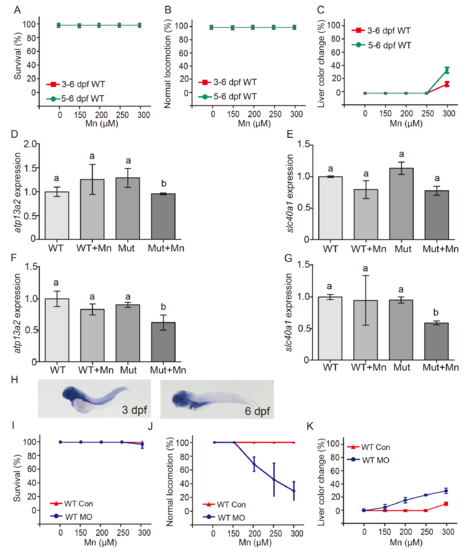Fig. S4
- ID
- ZDB-FIG-170830-24
- Publication
- Xia et al., 2017 - Zebrafish slc30a10 deficiency revealed a novel compensatory mechanism of Atp2c1 in maintaining manganese homeostasis
- Other Figures
- All Figure Page
- Back to All Figure Page
|
Atp2c1 functions as a Mn exporter in zebrafish embryos in early development. (A and B) Survival (A) and locomotor conditions (B) of wild-type embryos exposed to the indicated concentrations of Mn either for 72 h starting at day 3 dpf (3–6 dpf) or for 24 h starting at 5 dpf (5–6 dpf). (C) Percentage of embryos with a dark-colored liver after exposure to the indicated Mn concentrations. (D and E) Atp13a2 (D) and slc40a1 (E) mRNA levels were measured in wild-type and mutant embryos at 6 dpf; where indicated, the embryos were exposed to Mn at 3 dpf for 3 days. (F and G) Atp13a2 (F) and slc40a1 (G) mRNA levels were measured in wild-type and mutant embryos at 6 dpf; where indicated, the embryos were exposed to Mn at 5 dpf for 24 h. Groups with different letters differed significantly (p<0.05). (H) In situ hybridization for atp2c1 mRNA in wild-type embryos at 3 dpf and 6 dpf. (I-K) Wild-type embryos were injected with an atp2c1 morpholino (WT MO) or a scrambled morpholino (WT CON), then exposed to the indicated Mn concentration for 3 days at 3 dpf. (J and K) Injecting wild-type embryos with the atp2c1 morpholino facilitates Mn-induced locomotion deficits (J) and dark colored liver (K). |

